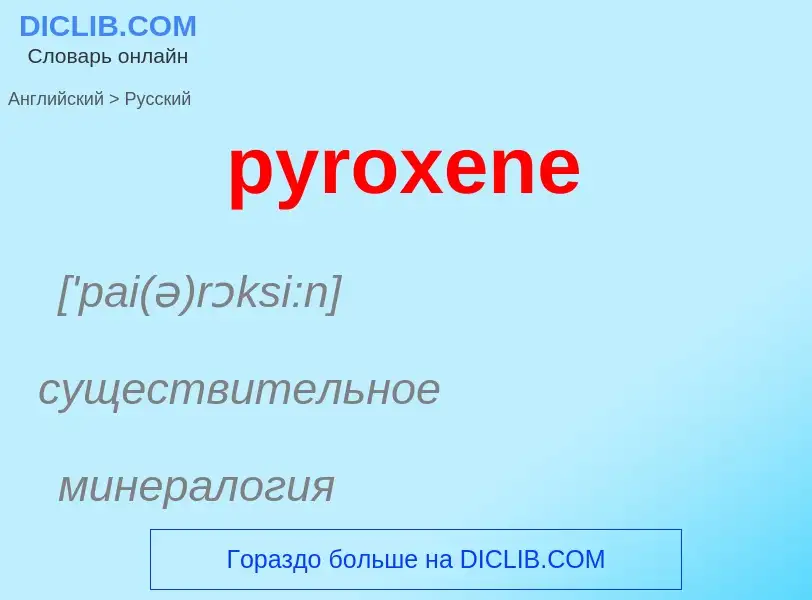Tradução e análise de palavras por inteligência artificial ChatGPT
Nesta página você pode obter uma análise detalhada de uma palavra ou frase, produzida usando a melhor tecnologia de inteligência artificial até o momento:
- como a palavra é usada
- frequência de uso
- é usado com mais frequência na fala oral ou escrita
- opções de tradução de palavras
- exemplos de uso (várias frases com tradução)
- etimologia
pyroxene - tradução para russo
['pai(ə)rɔksi:n]
существительное
минералогия
пироксен
Definição
Wikipédia

The pyroxenes (commonly abbreviated to Px) are a group of important rock-forming inosilicate minerals found in many igneous and metamorphic rocks. Pyroxenes have the general formula XY(Si,Al)2O6, where X represents calcium (Ca), sodium (Na), iron (Fe II) or magnesium (Mg) and more rarely zinc, manganese or lithium, and Y represents ions of smaller size, such as chromium (Cr), aluminium (Al), magnesium (Mg), cobalt (Co), manganese (Mn), scandium (Sc), titanium (Ti), vanadium (V) or even iron (Fe II or Fe III). Although aluminium substitutes extensively for silicon in silicates such as feldspars and amphiboles, the substitution occurs only to a limited extent in most pyroxenes. They share a common structure consisting of single chains of silica tetrahedra. Pyroxenes that crystallize in the monoclinic system are known as clinopyroxenes and those that crystallize in the orthorhombic system are known as orthopyroxenes.
The name pyroxene is derived from the Ancient Greek words for 'fire' (pyr πυρ) and 'stranger' (ksénos ξένος). Pyroxenes were so named because of their presence in volcanic lavas, where they are sometimes found as crystals embedded in volcanic glass; it was assumed they were impurities in the glass, hence the name meaning 'fire-strangers'. However, they are simply early-forming minerals that crystallized before the lava erupted.
The upper mantle of Earth is composed mainly of olivine and pyroxene minerals. Pyroxene and feldspar are the major minerals in basalt, andesite, and gabbro rocks.


![A [[thin section]] of green pyroxene A [[thin section]] of green pyroxene](https://commons.wikimedia.org/wiki/Special:FilePath/Microscopic image Pyroxene.jpg?width=200)
![A sample of [[pyroxenite]] (meteorite [[ALH84001]] from Mars), a rock consisting mostly of pyroxene minerals A sample of [[pyroxenite]] (meteorite [[ALH84001]] from Mars), a rock consisting mostly of pyroxene minerals](https://commons.wikimedia.org/wiki/Special:FilePath/Orthopyroxenite (ALH84001).gif?width=200)

![A single chain of silicon tetrahedra viewed in the [100] direction A single chain of silicon tetrahedra viewed in the [100] direction](https://commons.wikimedia.org/wiki/Special:FilePath/Ino a.jpg?width=200)
![A single chain of silica tetrahedra viewed in the [010] direction A single chain of silica tetrahedra viewed in the [010] direction](https://commons.wikimedia.org/wiki/Special:FilePath/Ino b.jpg?width=200)

